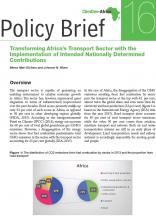Policy Brief 16 - Transforming Africa’s Transport Sector with Implementation of INDCs

The transport sector is capable of generating an enabling environment to catalyse economic growth in Africa. The sector has, however, experienced great stagnation in terms of infrastructural improvement over the past decades. Road access presently makes up only 34 per cent of such access in Africa, as opposed to 50 per cent in other developing regions globally (PIDA, 2015). According to the intergovernmental Panel on Climate (IPCC) (2014), energy use accounts for 68 per cent of total global greenhouse gas (GHG) emissions. However, a disaggregation of the energy sector shows that fuel combustion predominates total GHG emissions in the sector, with the transport sector accounting for 23 per cent globally (IEA, 2015).
In the case of Africa, the disaggregation of the GHG emissions resulting from fuel combustion by sector puts the transport sector at the top with 42 per cent, almost twice the global share, and even more than for electricity and heat production (32 per cent) (figure 1 is based on the International Energy Agency (IEA) data from the year 2015). Road transport alone accounts for 50 per cent of total transport sector emissions, while the other 50 per cent comes from aviation, maritime transport and railways. Both air and water transportation systems are still in an early phase of development. Land transportation (roads and railway systems) is accordingly responsible for moving goods and people.